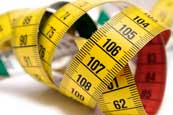 It’s no secret that body fat likes to make itself at home on your tummy, thighs and bum. However people who predominantly carry fat around their middle (as opposed to elsewhere on their body) are more prone to health issues such as type 2 diabetes and heart problems.
It’s no secret that body fat likes to make itself at home on your tummy, thighs and bum. However people who predominantly carry fat around their middle (as opposed to elsewhere on their body) are more prone to health issues such as type 2 diabetes and heart problems.
Working out your risk level is simple, as all you need is a trusty tape measure and the instructions below. You can do this by yourself at home, and no one else needs to know your measurements!
Measure your waist
On one side of your body (rather than the front), measure halfway between your lowest rib and the top of your hipbone (iliac crest). This is roughly in line with your belly button. Stand up and breathe out when you do this. Make sure your tummy muscles are completely relaxed, let it all hang out!
For women:
Ideal: less than 80cm (32”).
High: 80cm to 88cm (32” to 35”).
Very high: more than 88cm (35”).
For men:
Ideal: less than 94cm (37”).
High: 94cm to 102cm (37” to 40”).
Very high: more than 102cm (40”).
Measure your hips
Next, measure your hips at their widest point, the bum (ie. where your buttocks protrude the greatest). It's important not to cheat and pull the tape tight when doing either of these measurements!
Your waist-to-hip ratio
Divide your waist measurement by your hip measurement. A ratio of 1.0 or more in men or 0.85 or more in women indicates that you are carrying too much weight around your middle. This puts you at increased risk of diseases that are linked to obesity, such as type 2 diabetes and heart disease.
Focus on improvement
Anyone who is carrying excess weight, regardless of where on the body, would benefit from adopting a healthier lifestyle. Set some realistic weight loss goals, and focus on improving your measurements, rather than dwelling on what your “norm” should be.
You only have one body, so look after it!
Heather
